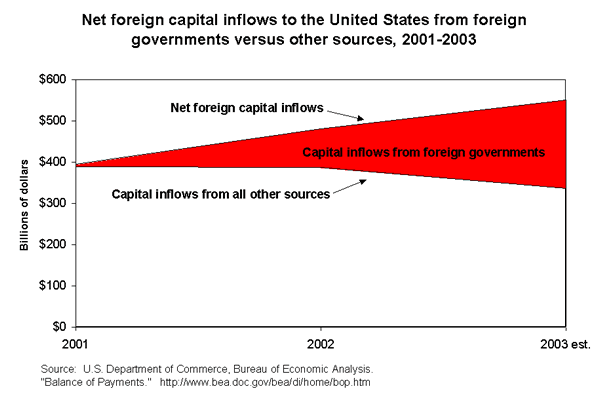See Snapshots Archive.
Snapshot for January 7, 2004.
Soaring trade deficit threatens to destabilize U.S. financial markets
The current account, the broadest measure of the U.S. deficit in trade of goods, services, and payments to the rest of the world is on pace to reach an all-time high of $551 billion for 2003, an increase of 15% over 2002. This 2003 trade deficit will exceed 5% of U.S. gross domestic product (GDP). A major factor contributing to the rising trade deficit is the purchase of large amounts of U.S. assets by foreign governments in order to influence the value of the U.S. dollar.
A trade deficit must be financed by net borrowing from other countries. The United States was effectively spending 5% more than it was producing last year, but cannot continue to borrow at such a high rate indefinitely. Worse yet, the trade deficit is growing each year as a share of GDP. Some government officials have suggested that such high levels of foreign borrowing do not pose a problem. Treasury Secretary John Snow recently said that “our current account deficit in large part reflects the attractive investment environment and high growth of productivity in the United States” (Senate Banking Committee on October 30, 2003). This statement ignores a serious problem resulting from the rising U.S. trade deficit: a growing dependence on lending by foreign governments bent on maintaining large trade surpluses with the United States.
If the value of the dollar were on the rise simply because of growing demand from investors who find the U.S. market attractive, then steady growth in capital inflows from private investors to finance rising deficits would likely occur. However, private inflows have fallen in the last two years. Instead, foreign governments have been intervening in foreign exchange markets by purchasing a rapidly growing amount of U.S. government assets (shown as capital inflows from foreign governments in the figure below*).

This intervention by other governments in foreign exchange markets prevented the dollar from falling more rapidly during this period. Without such intervention, the dollar would have declined at a faster rate and the U.S. trade deficit would by now be shrinking rather than continuing to grow.
* This inflow of capital from foreign governments reflects the sharp rise in foreign reserves of the governments of China, Japan, South Korea, and Taiwan. See October 30, 2003 snapshot on China’s reserves.
This week’s Snapshot was written by EPI economist Robert E. Scott with research assistance by Adam Hersh.
